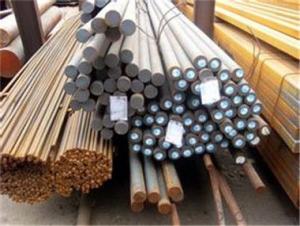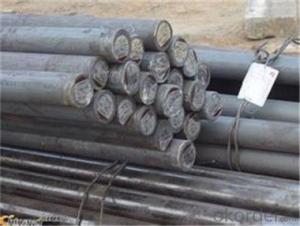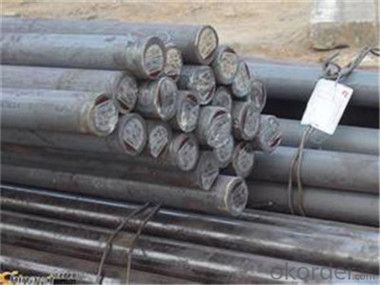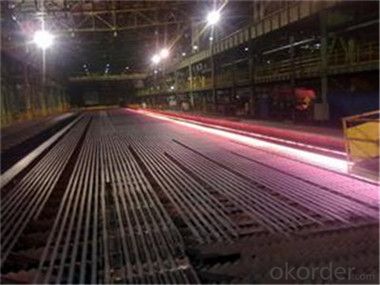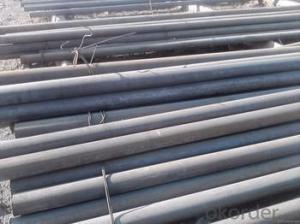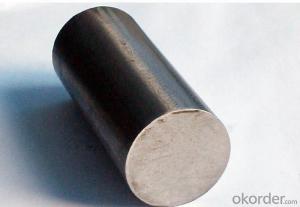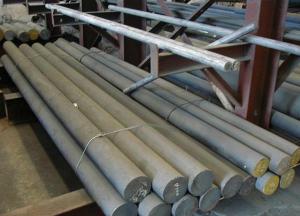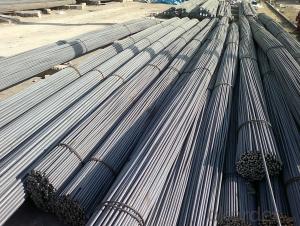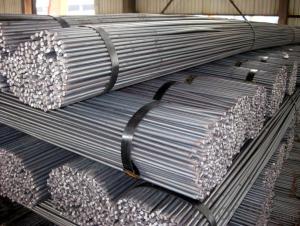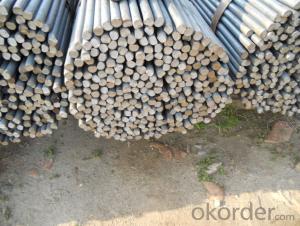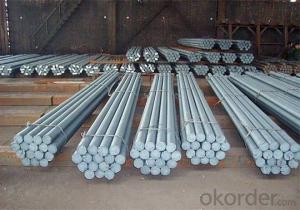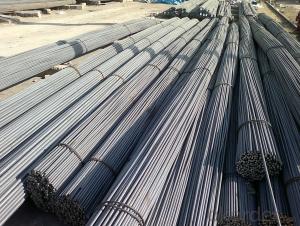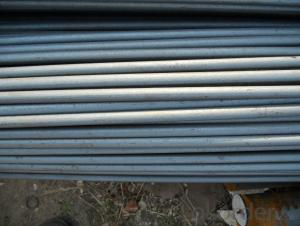Carbon Steel Round Bar for Hydraulic Cylinders
- Loading Port:
- Tianjin
- Payment Terms:
- TT OR LC
- Min Order Qty:
- 66 m.t.
- Supply Capability:
- 2000000 m.t./month
OKorder Service Pledge
OKorder Financial Service
You Might Also Like
Description of steel round bar:
1. Commodity: Round steel bar
3. Technical: Hot rolling
2. Length: Min. 5.8meter, according to requirement.
3. Diameter: 16mm-250mm
5. Packing: In Bundle or according to your requirements.
Festures of steel round bar:
1.Dia 80-800mm Length:2000-13000mm or as required
2.Technique:Forged
3.Delivery Time:45 days
Specifications of steel round bar:
Carbon steel rod applies to chemical industry, shipping industry,manufacturing industry,construction,decorate Industry,electric power,pump shafts, sanitary wares,furniture handles,boil,high temperature resistant,low temperature resistant, corrosion resistant.
Chemical Composition
| C | Mn | Si Max | S Max | P Max |
| 0.40-0.50 | 0.60-0.90 | 0.035 | 0.035 | 0.035 |
Images of steel round bar:
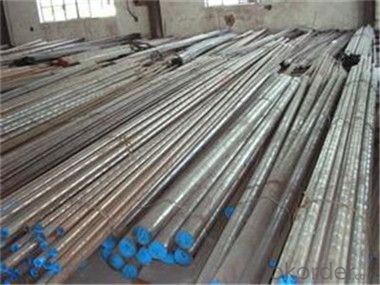
FAQ:
1. What is your package?
Packing situation: standard seaworthy packing or as customer required.
2. How long is the lead time?
Delivery time: 45 days after order confirmed.
3. What payment term do you accept?
Payment: T/T or L/C at sight.
- Q: What are the quality control measures for steel round bars?
- Steel round bars are subject to a series of inspections and tests to ensure that they meet the necessary standards and specifications. These measures play a vital role in guaranteeing the bars' structural integrity and reliability. Common quality control measures for steel round bars include: 1. Visual Inspection: Bars are visually examined to identify any surface defects like cracks, pits, or rust. This ensures that the bars have a smooth surface finish and are free from visible imperfections. 2. Dimensional Inspection: The diameter, length, and straightness of the bars are measured to ensure they adhere to the required tolerances. Any deviations from the specified dimensions can impact the bars' performance and compatibility in different applications. 3. Chemical Composition Analysis: Chemical composition analysis is carried out to confirm the percentage of various elements present in the steel. This analysis ensures that the bars possess the correct alloying elements in the proper proportions, which directly influence their mechanical properties and performance. 4. Mechanical Testing: Various mechanical tests are conducted to assess the bars' strength, hardness, and other mechanical properties. These tests may include tensile, impact, and hardness testing. They help determine if the bars meet the necessary durability and strength standards. 5. Ultrasonic Testing: Ultrasonic testing is often employed to detect internal defects such as voids, inclusions, or cracks within the steel round bars. This non-destructive testing technique utilizes high-frequency sound waves to identify flaws that may compromise the bars' structural integrity. 6. Surface Treatment Inspection: If the steel round bars undergo any surface treatments like heat treatment or coating, an inspection is conducted to ensure that these treatments are correctly applied and meet the required specifications. 7. Certification and Documentation: Quality control measures also encompass proper documentation and certification of the steel round bars. This ensures traceability and provides evidence that the bars have undergone the necessary inspections and tests, instilling confidence in customers regarding the product's quality. In summary, these quality control measures for steel round bars guarantee their high quality, compliance with necessary specifications, and suitability for their intended applications.
- Q: How do I choose the right grade of steel round bar for my application?
- To select the appropriate grade of steel round bar for your needs, it is crucial to carefully consider various factors. Here are some guidelines to assist you in making an educated decision: 1. Begin by understanding the specific requirements of your application. Take into account factors like load-bearing capacity, resistance to corrosion, temperature endurance, and any applicable industry regulations or standards. 2. Determine the mechanical properties necessary for your application. Depending on the specific use, you may require certain properties such as strength, hardness, toughness, or ductility. Prioritize these properties based on their significance to your application. 3. Assess the environmental conditions in which the steel round bar will be used. This includes factors like exposure to moisture, chemicals, high temperatures, or abrasive surroundings. Certain grades of steel offer better resistance to corrosion or heat, rendering them more suitable for specific conditions. 4. Seek guidance from experts if you are uncertain about the most suitable grade of steel for your application. Consult metallurgists, engineers, or suppliers who can provide valuable insights based on their expertise and experience. 5. Compare and contrast different grades of steel round bars available in the market once you have a clear understanding of your application requirements. Consider factors such as composition, manufacturing process, and specific properties associated with each grade. Look for grades that closely align with your requirements. 6. Review the industry standards and specifications to determine if any specific grades are mandated for your application. These standards can offer guidance and ensure compliance with safety and quality requirements. 7. Evaluate the cost-effectiveness of various grades by considering factors like initial purchase cost, maintenance and replacement expenses, and the overall lifespan of the steel round bar. 8. If possible, conduct tests or trials using different grades of steel round bars to assess their performance in your specific application. This will provide valuable data to aid your decision-making process. By following these steps and taking all relevant factors into account, you can efficiently and effectively select the appropriate grade of steel round bar that meets the demands of your application.
- Q: Can steel round bars be used for making gates?
- Indeed, gates can be made using steel round bars. The strength, durability, and versatility of steel round bars make them a favored option for gate production. Welding them together to achieve the desired gate design is a simple task, and they possess the capacity to endure substantial loads and impacts. Furthermore, steel round bars can undergo galvanization or coating processes in order to safeguard them against rust and corrosion, enhancing the gate's longevity. As a result, steel round bars are an appropriate material for constructing gates and are frequently employed in residential, commercial, and industrial settings.
- Q: How are steel round bars used in the automotive industry?
- Steel round bars are commonly used in the automotive industry for various applications such as manufacturing of axles, drive shafts, suspension components, and steering systems. These bars provide high strength and durability, allowing them to withstand the heavy loads and harsh operating conditions of vehicles. Additionally, steel round bars can be machined and formed into desired shapes, making them versatile and suitable for different automotive parts.
- Q: What are the different types of heat treatment for steel round bars?
- There are several different types of heat treatment methods commonly used for steel round bars. These methods are employed to improve the mechanical properties and overall performance of the steel. The most commonly used heat treatment processes for steel round bars include annealing, normalizing, quenching, tempering, and case hardening. 1. Annealing: This heat treatment process involves heating the steel round bars to a specific temperature and then slowly cooling them to room temperature. Annealing helps in reducing internal stresses, improving machinability, and increasing ductility. 2. Normalizing: In normalizing, the steel round bars are heated to a temperature above the critical range and then allowed to cool in still air. This process helps in refining the grain structure and enhancing the mechanical properties of the steel, such as strength and toughness. 3. Quenching: Quenching involves heating the steel round bars to a high temperature and then rapidly cooling them by immersing them in a quenching medium, such as water, oil, or polymer. This process results in the formation of a hardened microstructure, increasing the hardness and wear resistance of the steel. 4. Tempering: After the quenching process, the steel round bars are subjected to tempering. Tempering involves reheating the quenched steel to a specific temperature and then cooling it in still air. This process reduces the brittleness caused by quenching, increases the toughness of the steel, and helps in relieving residual stresses. 5. Case hardening: This heat treatment process is used to increase the hardness and wear resistance of the outer surface of the steel round bars while maintaining a tough and ductile core. Case hardening involves heating the steel in the presence of a carbon-rich atmosphere or by applying a carbon-rich substance, followed by quenching and tempering. Each of these heat treatment methods has its own advantages and is used based on the desired properties and applications of the steel round bars. It is important to carefully select the appropriate heat treatment process to achieve the desired mechanical properties and performance of the steel.
- Q: Can steel round bars be used for making steering components?
- Yes, steel round bars can be used for making steering components. Steel is a commonly used material for steering system components due to its high strength and durability. Steel round bars can be machined or forged into various shapes and sizes to create steering components such as steering shafts, tie rods, and drag links. These components need to be able to withstand the forces and stresses exerted on them during steering and steel's properties make it suitable for this purpose. Additionally, steel is readily available and cost-effective, making it a popular choice for manufacturing steering components in various industries, including automotive and aerospace.
- Q: Can steel round bars be used for making propeller shafts?
- Yes, steel round bars can be used for making propeller shafts. Steel is a common material choice for propeller shafts due to its strength, durability, and resistance to corrosion. The round shape of the steel bar allows for efficient transfer of rotational energy, making it suitable for propeller shafts in various applications.
- Q: What are the applications of steel round bars?
- Steel round bars have a wide range of applications across various industries due to their inherent strength, durability, and versatility. Some of the key applications of steel round bars include: 1. Construction: Steel round bars are extensively used in the construction industry for various structural purposes. They are commonly used for building columns, beams, and frames due to their high strength-to-weight ratio, which ensures stability and safety in construction projects. 2. Manufacturing: Steel round bars are widely used in the manufacturing sector for fabricating various components and machinery. They are commonly employed in the production of gears, shafts, axles, and other machine parts that require high strength and precision. 3. Automotive industry: Steel round bars find significant applications in the automotive industry. They are used in the manufacturing of crankshafts, connecting rods, suspension components, and many other parts, providing strength and reliability to vehicles. 4. Oil and gas industry: In the oil and gas sector, steel round bars are used for manufacturing drill bits, valves, pipes, and other equipment that are exposed to harsh environmental conditions and require high strength and corrosion resistance. 5. Aerospace industry: Steel round bars are essential in the aerospace industry due to their high strength and lightweight properties. They are used in the production of aircraft components, such as landing gear, engine parts, and structural components. 6. Shipbuilding: Steel round bars are commonly used in shipbuilding due to their excellent strength and corrosion resistance. They are used in the construction of ship frames, hulls, and other critical components that require durability and resistance to harsh marine environments. 7. Infrastructure projects: Steel round bars are extensively used in infrastructure projects, such as bridges, tunnels, and railways. They provide the necessary strength and stability required for supporting heavy loads and ensuring the structural integrity of these projects. 8. Furniture and interior design: Steel round bars are also used in the furniture and interior design industry. They are commonly employed in the construction of chairs, tables, shelves, and other furniture pieces due to their sleek appearance, durability, and easy formability. Overall, steel round bars have a wide range of applications in various industries, contributing to the development of robust and reliable structures, machinery, and equipment.
- Q: Can steel round bars be used for making exercise equipment?
- Yes, steel round bars can be used for making exercise equipment. Steel round bars are known for their durability and strength, making them suitable for constructing various types of exercise equipment. They can be used to create weightlifting bars, dumbbells, barbells, and other fitness equipment that require sturdy and reliable materials. Additionally, steel round bars can be easily machined, welded, and shaped into different forms, allowing for customization and versatility in exercise equipment design. The use of steel round bars ensures that the exercise equipment can withstand heavy loads and provide stability during workouts, making them a popular choice among gym equipment manufacturers and fitness enthusiasts.
- Q: What is the difference between a centerless ground and a hot rolled steel round bar?
- Two distinct types of steel bars are the centerless ground steel round bar and the hot rolled steel round bar. To begin with, the manufacturing process for each type varies. The centerless ground steel round bar is produced by passing it through a centerless grinder, which eliminates any surface imperfections and ensures a precise and smooth finish. This process guarantees tight tolerances and a consistent diameter throughout the bar's length. On the other hand, the hot rolled steel round bar is created by subjecting the steel billet to extremely high temperatures and then rolling it through a series of mills to achieve the desired shape and size. As a result, the surface finish of hot rolled steel bars is rougher compared to centerless ground steel bars. In terms of physical properties, centerless ground steel bars generally exhibit a higher level of dimensional accuracy and straightness due to the precision grinding process. This makes them suitable for applications requiring tight tolerances and precise measurements, such as the manufacturing of machinery parts or precision tools. Conversely, hot rolled steel round bars are renowned for their strength and durability. The heating and rolling process imparts desirable mechanical properties to the steel, such as increased hardness and toughness. These bars are commonly used in general construction, structural applications, and fabrication projects where strength and reliability are paramount. In conclusion, the key distinction between a centerless ground steel round bar and a hot rolled steel round bar lies in their manufacturing processes, surface finish, and intended applications. While centerless ground bars offer superior dimensional accuracy and smoothness, hot rolled bars are valued for their strength and resilience. The choice between the two depends on the specific requirements of the application at hand.
Send your message to us
Carbon Steel Round Bar for Hydraulic Cylinders
- Loading Port:
- Tianjin
- Payment Terms:
- TT OR LC
- Min Order Qty:
- 66 m.t.
- Supply Capability:
- 2000000 m.t./month
OKorder Service Pledge
OKorder Financial Service
Similar products
Hot products
Hot Searches
Related keywords
